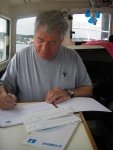Ordutch1975
New member
I took my boat out for the first time for an overnight in pretty much constant rain trip this weekend on the Columbia with 2 other buddies, between out body heat/breathing we accumulated quite some condensation on the inside of the windows etc which is quite frustrating when trying to navigate the waters. I know I should probably get a heater like a wallas or wabasto or something. I don't want to spend a fortune and don't want to have a cook top. For me its about heat like a forced air system or the like. So my question is:
What system should I get for a reasonable price that comes with good install instructions which I can follow myself? Where would I keep the fuel/diesel/lkerosene etc. We had a gas buddy heater but as we all know unvented heating only leads to more condensation.
Help - I want to be able to enjoy the boat no matter what weather we have.
Thanks all,
Harald
What system should I get for a reasonable price that comes with good install instructions which I can follow myself? Where would I keep the fuel/diesel/lkerosene etc. We had a gas buddy heater but as we all know unvented heating only leads to more condensation.
Help - I want to be able to enjoy the boat no matter what weather we have.
Thanks all,
Harald



